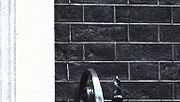
Tuckpointing
Encyclopedia

Mortar (masonry)
Mortar is a workable paste used to bind construction blocks together and fill the gaps between them. The blocks may be stone, brick, cinder blocks, etc. Mortar becomes hard when it sets, resulting in a rigid aggregate structure. Modern mortars are typically made from a mixture of sand, a binder...
in brickwork
Brickwork
Brickwork is masonry produced by a bricklayer, using bricks and mortar to build up brick structures such as walls. Brickwork is also used to finish corners, door, and window openings, etc...
, one colour matching the bricks themselves, to give an artificial impression that very fine joints have been made.
History
The method was developed in England in the late eighteenth century to imitate brickwork constructed using rubbed bricks (also rubbers or gauged bricks): bricks of fine red finish which were made slightly oversize and then individually abradedAbrasive
An abrasive is a material, often a mineral, that is used to shape or finish a workpiece through rubbing which leads to part of the workpiece being worn away...
or cut, often by hand, to a precise size after firing. When laid with white lime mortar a neat finish of red brick contrasting with very fine white joints was obtained. Tuckpointing was a way of achieving a similar effect using cheap, unrubbed bricks: these were laid in a mortar of a matching colour (initially red, but later blue-black bricks and mortar were occasionally used) and a fine fillet of white material, usually pipeclay or putty, pushed into the joints before the mortar set. The name derives from an earlier, less sophisticated technique used with very uneven bricks: a thin line, called a tuck, was drawn in the flush-faced mortar but left unfilled, to give the impression of well-formed brickwork.
Other usage
In some parts of the United States and Canada, some confusion may result as the term is often used interchangeably with "pointing" (to correct defects or finish off joints in newly laid masonry) and "repointingRepointing
Repointing is the process of renewing the pointing in masonry construction. Over time, weathering and decay cause voids in the joints between masonry units , allowing the undesirable entrance of water. Water entering through these voids can cause significant damage through frost weathering and...
" (to place wet mortar into cut or raked joints to repair weathered joints in old masonry).
Tuckpointing tools
Professional "tuckpointers" use tuckpointing tools, which depending on country and local trade terminology sometimes may be termed "jointers" or "tuckpointing irons" (primarily in London where the trade originated).The tools themselves are made from a hardened quality tool steel and are shaped with a sharp-pointed front with a flat base. They have a wooden handle which is attached with a brass ferrule.
Thicknesses or widths of tuckpointing tools may be between 2 mm and 10 mm depending on the tuckpointers' personal preferences. Standard tuckpointing tools most commonly used in industry are usually 4 mm and 6 mm thick.
Lengths of tools also vary depending on personal preferences, but the most common lengths are usually between 75 and 125 mm. However professionals sometimes like a much shorter tool, for instance one 30 mm long which is flat on the front in order to get into hard to reach spots, for instance under window brick work and in corners.
Tools are sometimes "beaded". This means that a small rounded fillet is ground into the flat of the tuckpointing tool that comes into contact with the "perps" or "lines" in the brickwork. (In bricklaying terms, "perp" is a bricklaying term for the gap between the bricks in which mortar runs in the vertical direction, perpendicular to the ends. "Lines" run in the horizontal direction).
Tuckpointing is a fairly rare but not forgotten trade. Many historic homes with classic Italianate architecture
Italianate architecture
The Italianate style of architecture was a distinct 19th-century phase in the history of Classical architecture. In the Italianate style, the models and architectural vocabulary of 16th-century Italian Renaissance architecture, which had served as inspiration for both Palladianism and...
like the Werribee Mansion at Werribee Park
Werribee Park
Werribee Park is the estate of a historical building in Werribee, Victoria, Australia. It includes Werribee Park Mansion, the Victoria State Rose Garden, formal gardens, the Werribee Park National Equestrian Centre, the Werribee Open Range Zoo, a contemporary sculpture walk and a natural riverine...
, in Victoria, Australia west of Melbourne, show good examples of recent tuckpointing which display the contrast between the tuckpointed white lines in the mortar between the bluestone architecture.
Tuckpointing in Australia, although originally considered to be part of the bricklaying trade, is now mainly performed by Tuckpointing specialists.
External links
- Pointing in Brick Walls Pictures of original and restored tuck pointing, accessed 2009-04-04.

